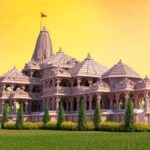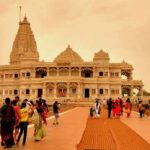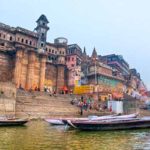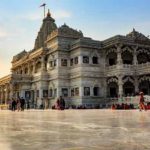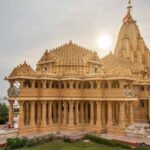Places to Visit in Ayodhya, located in the northern Indian state of Uttar Pradesh, is a city steeped in history, spirituality, and cultural significance. It is primarily known as the birthplace of Lord Rama, a revered figure in Hindu mythology. This ancient city attracts pilgrims, history enthusiasts, and curious travelers from all over the world.
The focal point of Ayodhya’s tourism is undoubtedly the Ram Janmabhoomi, the believed birthplace of Lord Rama. The site holds immense religious importance for Hindus and has been a subject of historical and political significance. The recently constructed Ram Mandir stands as a testament to the city’s spiritual heritage, drawing devotees and architecture enthusiasts alike.
Besides the Ram Janmabhoomi, Ayodhya boasts a plethora of other attractions. The Hanuman Garhi, a temple dedicated to Lord Hanuman, is another revered site in the city. It is perched atop a hillock and offers a panoramic view of Ayodhya. The Kanak Bhavan, an intricately designed palace, is another must-visit site. Legend has it that it was a gift from Lord Rama to his wife, Sita.
The banks of the Sarayu River, which flows through Ayodhya, offer a serene setting for devotees to take a dip and seek spiritual solace. The ghats along the riverbank, such as the Guptar Ghat and Ram Ki Paidi, are popular spots for rituals and contemplation Religious Places in Rajasthan.
Ayodhya also boasts a rich cultural heritage, evident in its various festivals and events. Diwali, the festival of lights, is celebrated with unparalleled fervor and grandeur here, as it is believed to be the day Lord Rama returned to Ayodhya after his exile.
The city’s vibrant bazaars offer an array of handicrafts, religious artifacts, and local delicacies for visitors to explore and purchase as souvenirs. Ayodhya’s warm hospitality, coupled with its deep-rooted spirituality, makes it a destination that leaves an indelible mark on every visitor.
In conclusion, Ayodhya is a city that encapsulates India’s cultural, religious, and historical essence. Its spiritual significance, coupled with its rich history, makes it a must-visit destination for anyone seeking a deeper understanding of Indian heritage and spirituality Rajasthan Pilgrimage Tours.
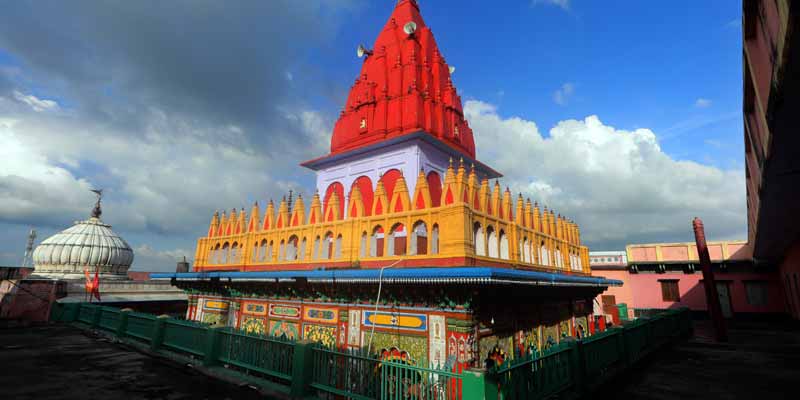
Shri Hanuman Garhi Mandir
Shri Hanuman Garhi Mandir, situated in Ayodhya, Uttar Pradesh, is a prominent Hindu temple dedicated to Lord Hanuman. Perched atop a hillock, it is one of the most revered and visited religious sites in Ayodhya. The temple complex is a striking example of architectural brilliance and holds a special place in the hearts of devotees.
The temple is believed to have been established by the Mughal Emperor Aurangzeb’s governor, in the 10th century. It is said that the emperor was a staunch devotee of Lord Hanuman and contributed to the construction of this temple Varanasi.
To reach the main sanctum, visitors have to ascend a flight of steep stairs, which lead to a spacious courtyard. The sanctum sanctorum houses a colossal idol of Lord Hanuman, believed to be in a reclining position, facing Lord Rama’s birthplace, Ram Janmabhoomi.
The panoramic view from Hanuman Garhi is one of its most enchanting features. It provides visitors with a breathtaking vista of Ayodhya, with the winding Sarayu River and the cityscape in the backdrop. Many devotees and tourists come here not only to seek blessings but also to admire the picturesque landscape.
Devotees throng to this temple throughout the year, but it holds special significance during festivals like Hanuman Jayanti, when it is adorned with vibrant decorations and the air is filled with devotional hymns.
Shri Hanuman Garhi Mandir is not only a place of religious importance but also a symbol of devotion, faith, and architectural splendor. Its serene ambiance, coupled with the spiritual energy it exudes, makes it a must-visit destination for pilgrims and tourists alike.
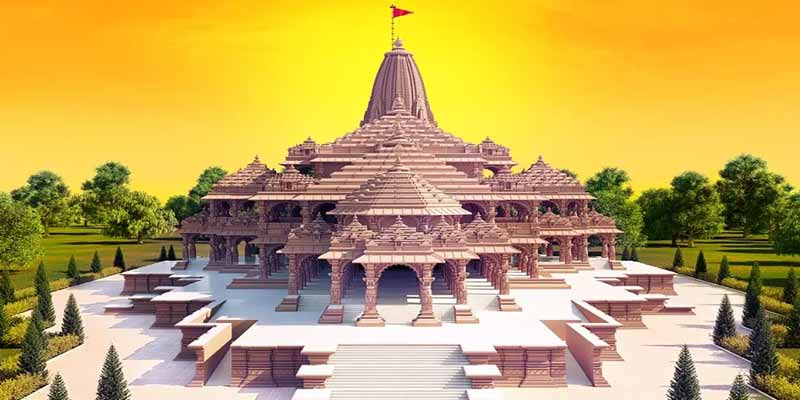
Shree Ramjanmbhumi Temple
The Shree Ramjanmbhumi Temple, also known as the Ram Mandir, is a highly revered Hindu temple located in Ayodhya, Uttar Pradesh, India. It stands at the site believed to be the exact birthplace of Lord Rama, a central figure in Hindu mythology and the seventh incarnation of Lord Vishnu.
The temple holds immense religious significance for millions of Hindus worldwide. The construction of the Ram Mandir has been a deeply cherished aspiration for centuries. It was realized after a historic Supreme Court verdict in 2019, which paved the way for the temple’s construction.
Architecturally, the Ram Mandir showcases a blend of classical and contemporary design elements. It boasts intricate carvings, majestic spires, and a grand courtyard. The sanctum sanctorum houses the idol of Lord Rama along with Goddess Sita, Lord Lakshmana, and Lord Hanuman.
The temple complex is not only a place of worship but also a symbol of cultural and spiritual unity for Hindus across the globe. It serves as a testament to India’s rich cultural heritage and its age-old traditions.
Pilgrims and tourists from various corners of the world visit the Ram Mandir to seek blessings, offer prayers, and marvel at its architectural grandeur. The atmosphere is one of devotion, serenity, and reverence.
The completion of the Shree Ramjanmbhumi Temple marks a significant milestone in the history of Ayodhya and India as a whole. It stands as a beacon of faith and a representation of the deep spiritual connection that millions of people share with Lord Rama. The temple complex is a place of pilgrimage, a cultural landmark, and a source of spiritual solace for countless devotees.
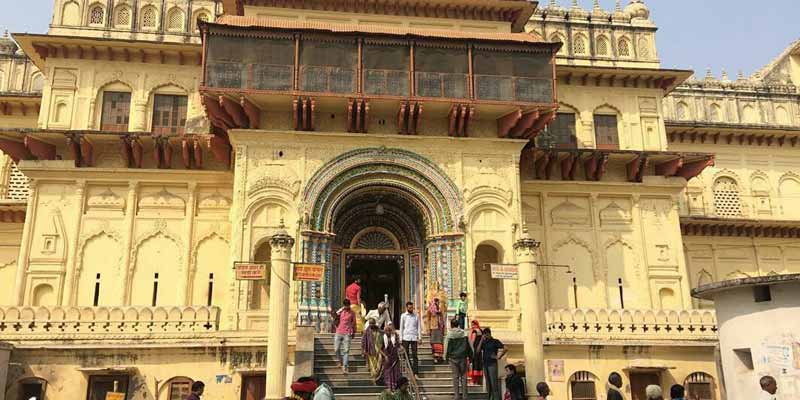
Kanak Bhawan
Kanak Bhavan, located in Ayodhya, Uttar Pradesh, is a revered Hindu temple steeped in history and cultural significance. It is believed to be a gift from Lord Rama to his wife Sita, making it a symbol of their eternal love and devotion.
This intricately designed palace-like structure is a testament to the rich architectural heritage of the region. Its name, “Kanak Bhavan,” translates to “Golden Palace” in English, a fitting moniker considering the opulent and ornate decorations that adorn its interiors.
The temple is a popular pilgrimage site for devotees of Lord Rama and Goddess Sita. It is situated in close proximity to the Ram Janmabhoomi and is an integral part of the religious circuit in Ayodhya. Pilgrims visit Kanak Bhavan to seek blessings for marital harmony and to pay homage to the divine couple.
The inner sanctum of Kanak Bhavan houses the idols of Lord Rama and Goddess Sita, beautifully adorned with exquisite jewelry and garments. Devotees offer prayers and perform rituals to seek the blessings of the divine couple for a blissful and harmonious married life.
Apart from its religious significance, Kanak Bhavan is also admired for its architectural grandeur. The intricate carvings, vibrant frescoes, and elaborate detailing on the walls and ceilings are a testament to the craftsmanship of the artisans of that era.
The serene surroundings of Kanak Bhavan, with its well-maintained garden and peaceful ambiance, provide a tranquil space for visitors to contemplate and soak in the spiritual atmosphere.
In summary, Kanak Bhavan stands as a symbol of love, devotion, and architectural excellence. Its historical and religious importance, coupled with its exquisite design, make it a prominent attraction for pilgrims and architecture enthusiasts alike in the sacred city of Ayodhya.
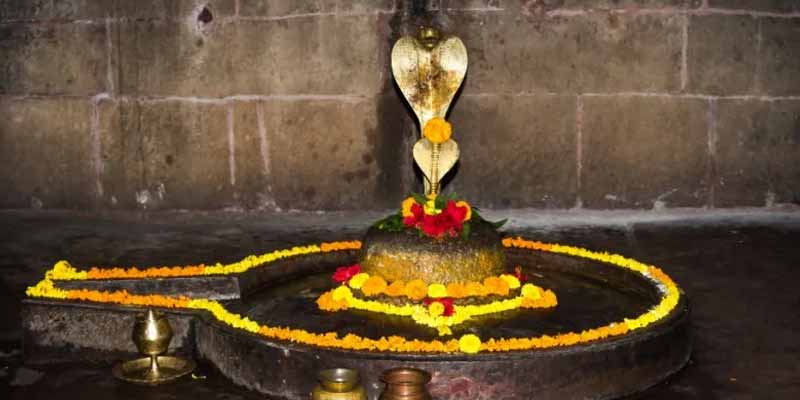
Sri Nageshwarnath Temple
The Sri Nageshwarnath Temple in Ayodhya is an ancient and revered Hindu temple dedicated to Lord Shiva. It holds a special place in the religious landscape of Ayodhya, Uttar Pradesh, India. The temple is located near the Ram Janmabhoomi complex, adding to its spiritual significance.
Legend has it that this temple was established by Lord Rama’s son, King Kusha, to enshrine a Shiva Lingam (a representation of Lord Shiva) that Lord Rama himself worshipped. This Lingam is believed to be self-manifested, making it especially sacred to devotees.
The architecture of the Sri Nageshwarnath Temple is a fine example of ancient Indian temple design. It features intricate carvings and sculptures that depict various mythological scenes and deities. The temple’s sanctum sanctorum houses the revered Shiva Lingam, and devotees gather here to offer their prayers and seek blessings from Lord Shiva.
The temple complex also includes other smaller shrines dedicated to different deities, creating a serene and spiritually charged atmosphere. Pilgrims and visitors can witness various rituals and ceremonies performed by the temple priests, adding to the overall experience.
Throughout the year, the Sri Nageshwarnath Temple hosts various religious festivals, with Mahashivaratri being the most significant. On this auspicious day, devotees from far and wide converge at the temple to offer special prayers and seek Lord Shiva’s blessings.
Visiting the Sri Nageshwarnath Temple provides not only a profound religious experience but also an opportunity to immerse oneself in the rich cultural and spiritual heritage of Ayodhya. The temple’s serene ambiance and architectural beauty make it a must-visit destination for both pilgrims and enthusiasts of Indian spirituality and history. It stands as a living testament to the enduring devotion of Lord Rama’s lineage and their reverence for Lord Shiva.
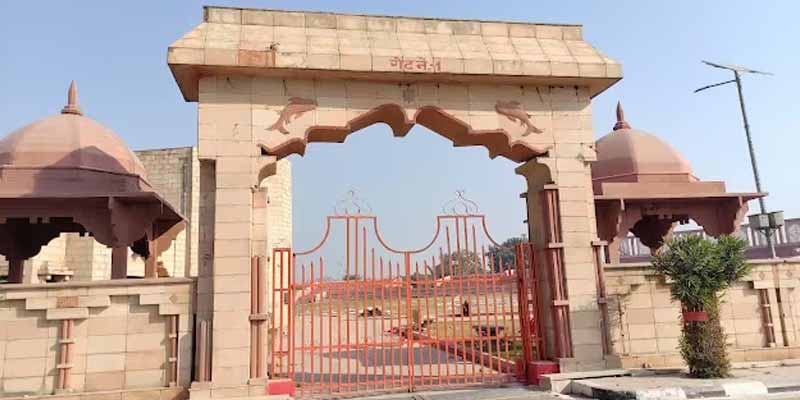
Ram Katha Park
Ram Katha Park in Ayodhya is a beautifully landscaped garden that serves as a tribute to the legendary epic of Ramayana. Spread across a sprawling expanse, this park offers a serene and contemplative atmosphere for visitors to connect with the ancient tale of Lord Rama.
The park is adorned with intricately carved sculptures and statues depicting scenes from the Ramayana, bringing the epic to life for visitors. These artistic representations are skillfully crafted, providing a visual narrative of the significant events and characters from the epic.
One of the main highlights of Ram Katha Park is a grand diorama that captures the entire story of Lord Rama’s life, from his birth in Ayodhya to his return after defeating the demon king Ravana. This captivating display is a powerful tool for educating visitors about the epic’s narrative and its moral lessons.
The park is not only a visual delight but also offers a space for contemplation and meditation. Many visitors come here to find solace and reflect on the profound teachings of Lord Rama, which are woven into the fabric of the Ramayana.
Furthermore, Ram Katha Park is designed to be accessible to people of all ages and interests. Its tranquil ambiance makes it an ideal place for families, spiritual seekers, and history enthusiasts alike. Additionally, the park often hosts cultural events and performances that celebrate the legacy of Lord Rama and the Ramayana.
Overall, Ram Katha Park in Ayodhya stands as a testament to the enduring significance of the Ramayana in Indian culture and spirituality. Its artful representations and serene surroundings provide a unique opportunity for visitors to immerse themselves in the timeless tale of Lord Rama and draw inspiration from its timeless wisdom.
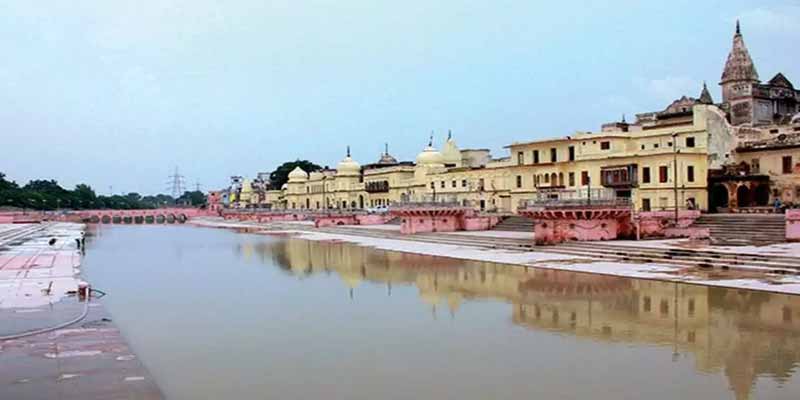
Saryu Ghat
Saryu Ghat, located in Ayodhya, Uttar Pradesh, is a revered and picturesque riverbank along the holy Sarayu River. This ghat holds immense spiritual significance in Hindu mythology and is a central pilgrimage site for devotees.
The Sarayu River is believed to be sacred, and taking a dip in its waters is considered purifying and spiritually uplifting. Saryu Ghat provides a serene and peaceful environment for devotees and visitors to engage in various religious activities and rituals.
One of the most significant aspects of Saryu Ghat is its association with the legendary Lord Rama. According to Hindu mythology, it is said that Lord Rama, along with his devoted wife Sita and loyal brother Lakshmana, embarked on a journey to exile from this very ghat. This event, known as the ‘Ram Van Gaman,’ is a pivotal moment in the epic Ramayana.
Devotees from all over India and beyond visit Saryu Ghat to pay their respects and seek blessings. The ghat is particularly bustling during major festivals and religious occasions, where elaborate ceremonies and aarti (rituals involving lamps) are performed.
The tranquil ambiance of Saryu Ghat, especially during the early morning or at sunset, offers a peaceful respite from the hustle and bustle of everyday life. Pilgrims and tourists often find solace in sitting by the riverside, meditating, or simply enjoying the view of the flowing waters.
The Ghat’s steps, made of stone, lead down to the river, providing easy access for devotees to perform their rituals or take a holy dip. The entire area is well-maintained, and there are facilities available for those who wish to participate in the various ceremonies.
In essence, Saryu Ghat in Ayodhya encapsulates the spiritual and historical essence of the city. It is a place where faith, devotion, and tranquility converge, offering visitors a profound connection to Hindu mythology and a sense of inner peace.
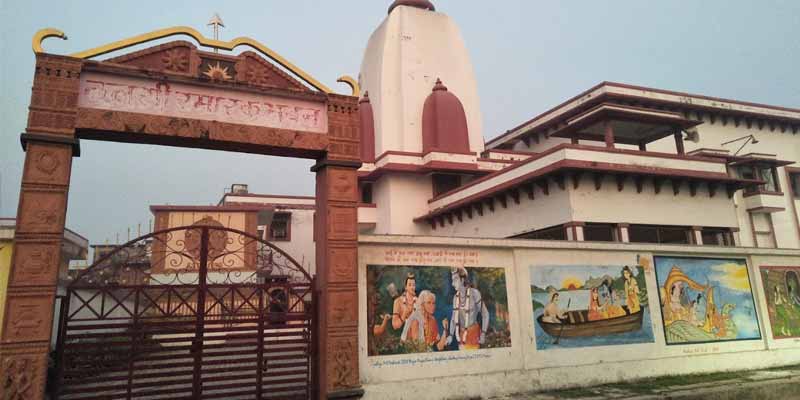
Tulsi Smarak
The Tulsi Smarak Bhawan in Ayodhya is a tribute to the renowned Hindu poet-saint, Goswami Tulsidas. This memorial is dedicated to preserving and promoting the literary and cultural legacy of Tulsidas, who is best known for composing the epic poem “Ramcharitmanas,” an important text in Hindu mythology that narrates the life and deeds of Lord Rama.
Situated on the banks of the Sarayu River, the Tulsi Smarak Bhawan is a magnificent structure that combines modern architectural elements with traditional design. The memorial complex comprises a central hall with exhibits that depict the life and works of Tulsidas. Visitors can explore various aspects of his life, including his early years, literary contributions, and spiritual philosophy.
The memorial also houses a well-curated library, which contains a vast collection of texts related to Tulsidas, as well as other important works of Hindu literature. This resource is invaluable for scholars, researchers, and devotees interested in delving deeper into the teachings and writings of Tulsidas.
One of the highlights of the Tulsi Smarak Bhawan is a beautifully landscaped garden surrounding the main building. This serene space provides a peaceful environment for reflection and meditation, aligning with the spiritual essence of Tulsidas’ teachings.
The Tulsi Smarak Bhawan plays a vital role in promoting the cultural heritage of Ayodhya and is a significant pilgrimage site for devotees of Tulsidas and Lord Rama. It serves as a hub for cultural events, seminars, and lectures, fostering a deeper understanding of Tulsidas’ profound impact on Indian literature and spirituality.
In essence, the Tulsi Smarak Bhawan stands as a fitting tribute to Goswami Tulsidas, immortalizing his contributions to Hindu philosophy and literature, and inviting visitors to explore the profound spiritual legacy he left behind Places to Visit in Ayodhya.



